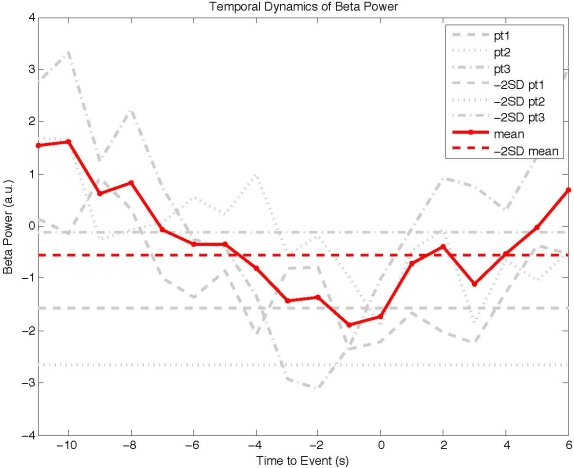Session Information
Date: Thursday, June 23, 2016
Session Title: Other
Session Time: 12:00pm-1:30pm
Location: Exhibit Hall located in Hall B, Level 2
Objective: To assess possible EEG spectral power changes prior to psychogenic non-epileptic seizures (PNES) and identify whether a “positive marker” of PNES may exist.
Background: PNES are the most common manifestation of functional (psychogenic) neurological symptoms. The diagnosis is based on a combination of the clinical presentation (incongruence with known epileptic syndromes) and neurophysiological features (no epileptic activity on EEG recordings during an attack). To date no “positive” diagnostic EEG features of PNES have been identified and the diagnosis is primarily based on the absence of epileptic activity during the seizure. Given the decreases in oscillatory beta (13-30 Hz) EEG power (desynchronization) prior to cued or self-paced movements and functional myoclonus (Meppelink et al., under review), we hypothesised to find a similar phenomenon in PNES.
Methods: EEG was recorded in three patients previously diagnosed with PNES, while a, for the individual typical non-epileptic seizure occurred. EEG time-frequency analyses were performed using Morlet wavelet transformations. Average (para)central beta power relative to baseline (-12 to -10 sec before seizure onset) was calculated. For each patient, twice the standard deviation of beta power in the baseline period was used to define significant beta power deviation.
Results: Each patient had a typical seizure with unresponsiveness (3/3 patients), loss of perception (1/3), head drop (1/3) and generalised shaking (1/3). All three patients showed beta desynchronisation prior to their attack with an increase of beta power (resynchronisation) afterwards (Fig 1). In two out of three patients beta power dropped below the 2SD line at respectively 1 and 3 s before the event. For subject 3, beta power did not drop under the 2SD line  .
.
Conclusions: This pilot study suggests that beta desynchronisation might occur prior to a non-epileptic attack. If confirmed in a larger study, it could potentially be a useful marker for PNES. Beta suppression prior to movement is thought to reflect a change in motor attention that promotes a new sensory state at the expense of the current state. If beta power suppression prior to the onset of PNES might somehow reflect an increase of motor attention, this challenges the current dissociation hypothesis. This idea is supported by the fact that patients report to be able to exert some control over their attacks.
To cite this abstract in AMA style:
A.M. Meppelink, I. Parees, M. Beudel, S. Little, M. Edwards. EEG Spectral power changes prior to non-epileptic seizures: A pilot study [abstract]. Mov Disord. 2016; 31 (suppl 2). https://www.mdsabstracts.org/abstract/eeg-spectral-power-changes-prior-to-non-epileptic-seizures-a-pilot-study/. Accessed December 30, 2025.« Back to 2016 International Congress
MDS Abstracts - https://www.mdsabstracts.org/abstract/eeg-spectral-power-changes-prior-to-non-epileptic-seizures-a-pilot-study/
